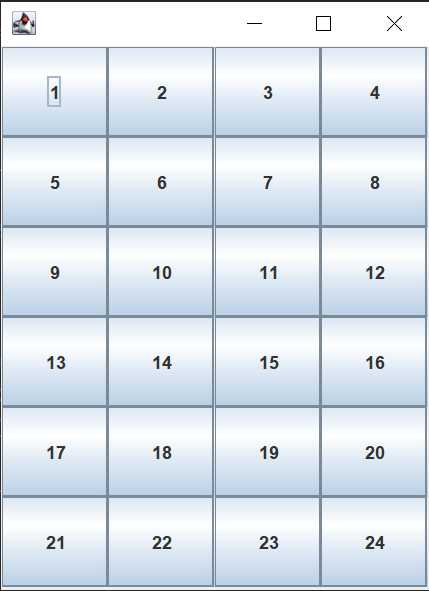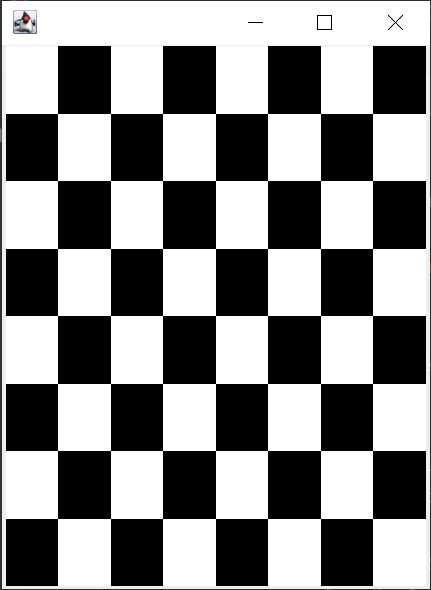布局:将控件有序的放在界面上
eg:将一个按钮,一个文本框放在界面上
import javax.swing.*;
import java.awt.*;
class Layout1 extends JFrame{
private JTextField jtf = new JTextField(20);
private JButton jbt = new JButton("按钮");
private JPanel jpl = new JPanel();
public Layout1(){
FlowLayout fl = new FlowLayout(FlowLayout.LEFT,20,20);
jpl.setLayout(fl);
this.add(jpl); jpl.add(jtf); jpl.add(jbt);
this.setSize(300,400);
this.setDefaultCloseOperation(EXIT_ON_CLOSE);
this.setVisible(true);
}
public static void main(String[] args) throws Exception {
new Layout1();
}
}
- FlowLayout
JPanel默认的布局方式是:流式布局(FlowLayout),优先放在1行,放不下,到后面1行。该布局方式由java.awt.FlowLayout来管理
任何容器管理类都有setLayout函数设置布局 - GridLayout:网格布局,将界面设置为多行多列的格子,放置控件。该布局方式由java.awt.GridLayout来管理
eg:放置24个按钮在界面上
import javax.swing.*;
import java.awt.*;
class Layout2 extends JFrame{
private JPanel jpl = new JPanel();
public Layout2(){
GridLayout gl = new GridLayout(6,4);
jpl.setLayout(gl);
this.add(jpl);
for(int i=1;i<=24;i++){
jpl.add(new JButton(String.valueOf(i)));
}
this.setSize(300,400);
this.setDefaultCloseOperation(EXIT_ON_CLOSE);
this.setVisible(true);
}
public static void main(String[] args) throws Exception {
new Layout2();
}
}
eg:8*8国际象棋棋盘
import javax.swing.*;
import java.awt.*;
class Layout3 extends JFrame{
private JPanel jpl = new JPanel();
public Layout3(){
GridLayout gl = new GridLayout(8,8);
jpl.setLayout(gl);
this.add(jpl);
for(int i=1;i<=8;i++){
for(int j=1;j<=8;j++){
JPanel pl = new JPanel();
if((i+j)%2==0) {
pl.setBackground(Color.white);}
else {
pl.setBackground(Color.black);}
jpl.add(pl);
}
}
this.setSize(300,400);
this.setDefaultCloseOperation(EXIT_ON_CLOSE);
this.setVisible(true);
}
public static void main(String[] args) throws Exception {
new Layout3();
}
}
- BorderLayout:边界布局。将界面分为东西南北中,添加控件。该布局方式由java.awt.BorderLayout来管理
eg:随意在各个方向测试边界布局
import javax.swing.*;
import java.awt.*;
class Layout4 extends JFrame{
private JPanel jpl = new JPanel();
public Layout4(){
BorderLayout bl = new BorderLayout();
jpl.setLayout(bl);
this.add(jpl);
jpl.add(new JButton("按钮"),BorderLayout.SOUTH);
jpl.add(new JTextField(),BorderLayout.NORTH);
jpl.add(new JTextArea(),BorderLayout.CENTER);
jpl.add(new JButton("按钮"),BorderLayout.WEST);
jpl.add(new JButton("按钮"),BorderLayout.EAST);
this.setSize(300,400);
this.setDefaultCloseOperation(EXIT_ON_CLOSE);
this.setVisible(true);
}
public static void main(String[] args) throws Exception {
new Layout4();
}
}
- 完全自由布局:控件的位置,大小,用坐标决定,而不是由界面大小决定。实际上是:设置容器布局为null,然后通过setSize设置大小,setLocation设置位置,设置的原因:坐标体系在不同的操作系统不能保证相同
eg:按键大小不随界面大小改变而改变的测试样例
import javax.swing.*;
import java.awt.*;
class Layout5 extends JFrame{
private JButton jbt = new JButton("按钮");
public Layout5(){
this.setLayout(null); //***
jbt.setSize(80,60);
jbt.setLocation(60,50);
this.add(jbt);
this.setSize(300,400);
this.setDefaultCloseOperation(EXIT_ON_CLOSE);
this.setVisible(true);
}
public static void main(String[] args) throws Exception {
new Layout5();
}
}
练习题和作业
练习:一个按钮,从界面上方以抛物线形式掉下来
import javax.swing.*;
import java.awt.*;
class Layout6 extends JFrame implements Runnable{
private JButton jbt = new JButton();
int X,Y = 0;
public Layout6(){
jbt.setIcon(new ImageIcon("img.jpg"));
this.setLayout(null);
jbt.setSize(80,60);
this.add(jbt);
this.setSize(300,400);
this.setDefaultCloseOperation(EXIT_ON_CLOSE);
this.setVisible(true);
Thread th = new Thread(this);
th.start();
}
public void run(){
while(true){
try{
Thread.sleep(20);} catch(Exception e){
}
X++; Y=X*X/100;
jbt.setLocation(X,Y);
}
}
public static void main(String[] args) throws Exception {
new Layout6();
}
}
作业:
图片上下弹跳
小球自由落体掉下,弹起来,再次自由落体
两个小球在界面上相向而行,碰撞之后反方向运行
小球,以正弦波形式向前运动
今天的文章Java界面布局管理(简单)分享到此就结束了,感谢您的阅读,如果确实帮到您,您可以动动手指转发给其他人。
版权声明:本文内容由互联网用户自发贡献,该文观点仅代表作者本人。本站仅提供信息存储空间服务,不拥有所有权,不承担相关法律责任。如发现本站有涉嫌侵权/违法违规的内容, 请发送邮件至 举报,一经查实,本站将立刻删除。
如需转载请保留出处:https://bianchenghao.cn/31691.html


